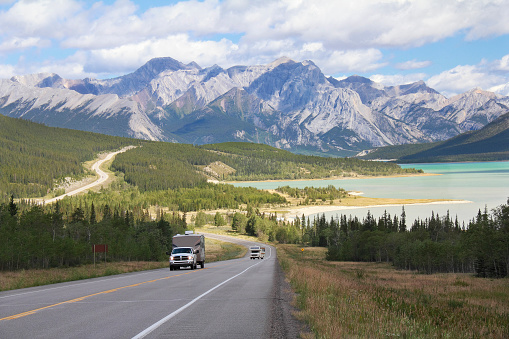 Hi, folks. We are coming up on RVing weather, so it’s time to get your rig ready for travel. If you have any de-winterizing or after-storage questions, send them to [email protected] and we’ll cover them in the next couple of columns.
Hi, folks. We are coming up on RVing weather, so it’s time to get your rig ready for travel. If you have any de-winterizing or after-storage questions, send them to [email protected] and we’ll cover them in the next couple of columns.
——————————————
Mark, I have a 24ft Class C motor home. I read with interest your January article about running the refrigerator off the storage battery (non-engine) while driving or possibly for short periods when parked. I have a 2K watt (4K peak) inverter and connecting to the battery is the easy part. How do I connect to the refrigerator? Is it 12v or 120v? I see that there are 2-way and 3-way refrigerators. Do I use a dual male cord and plug into the inverter into any outlet? That would put 120V into the system, but would bypass the circuit breakers. Any information you can offer would be great. Doug.
Hi, Doug
The idea is to use the inverter to supply 120VAC power to run the refrigerator in AC mode. To accomplish this, we need to either run a separate 120V circuit from the inverter to the fridge, or tie the inverter’s 120V output to selected circuits in the RV using a transfer switch. Under no circumstances should you ever use a male to male AC power cord between the inverter and an AC outlet to accomplish this. This is very dangerous, as you would wind up with 120VAC present on the unshielded lugs of your RV power cord plug! One possibility is to run a dedicated circuit from the inverter output to a dedicated 120V outlet located in the refrigerator outside compartment. With this setup, you’d have to plug the refrigerator AC cord into the dedicated outlet when you wanted to run it on the inverter. A better answer would be to install a transfer switch, either manually operated or automatic, that would switch selected AC circuits between shore power and the inverter. This is really something that requires a qualified electrician to implement. Inverters that are designed for RV use often incorporate this transfer switch into their design. 120VAC can kill you, so safety is of the utmost concern here. An inverter designed for RV use that hard-wires to the battery system and incorporates the transfer switch function is really the best way to go. If your present inverter does not have that capability, you may want to consider replacing it with one that does.
—————————–
Hello Mark;
I’m wondering if it is a good idea to engage my trailer breakaway switch by pulling out the breakaway key to lock my trailer brakes while parked in a campground with a non-level site? Would this action damage the magnet in my electric brakes if I left it that way for several days? Would this cause my battery to drain quickly and affect my ability to dry camp for longer periods? Kindest Regards, Bob
Hi, Bob
That’s not a good idea for several reasons: First, the trailer brakes are not designed to be powered constantly, so the magnets may overheat and fail, leaving you with no brakes for the road home. Also, it is best not to pull out that emergency breakaway lanyard except for an occasional test. When the pin is pulled out, the switch contacts inside the housing are left exposed to the weather, and that may cause the switch to get dirty or corroded, and prevent it from working if you ever need it to. And, yes, it would run your house batteries down, as that’s where the power is drawn from. An inexpensive set of plastic wheel chocks will do the job just fine, and are lightweight and easy to stow.
————————————————–
Hi, Mark
We have been following this site for years and are now moving up to a bigger Travel Trailer and the question we have is the rear view camera for the Trailer. The newer Trailers list a camera ready feature but what do we have to do to get a camera hooked up? Our Tow Vehicle is a new 2016 Tundra that has a great tow package as well as a rear view camera. The cameras out there for trailers range in price from $45 to $500 dollars. What would you recommend for a 30-32 ft. Trailer? Also, the Tundra has standard Tow mirrors but I fear that they might not be adequate so now we are talking about after market. What brand or kind of mirror extension would you recommend? Thank You Kindly, Jack and Jeanne
Hi, Jack and Jeanne
A rear view camera on the trailer can be a very handy thing to have, and thanks to wireless technology, they can be easy to implement. In my experience, “camera ready” on an RV generally means there’s a mounting plate back there, and 12VDC power is already run to the area. This makes it even easier to install. Check out this excellent article on the Fulltime Families site: http://fulltimefamilies.com/rv-kids/rear-view-camera-on-travel-trailer-and-5th-wheel/ . They have covered the bases very well! My Rand McNally GPS has a built in camera monitor function, and I have been thinking about doing this myself. Please let me know if you go for it and how hard/easy it was, and I’ll be glad to share your experiences here in my column.
On the mirrors: first, check to see if your existing mirrors can be extended for towing. Many truck mirrors will slide outward far enough to be adequate for towing. If not, any RV parts source will have extension mirrors available that simply attach to your stock mirrors. You may be able to purchase extension mirrors designed specifically for your make and model truck, or you can purchase a universal mirror. I like the CIPA 11960, as it has a ratchet style strap that allows you to really tighten it securely, but is super easy to install and remove. Amazon has them, as will most RV stores.
———————————————
Hi, Mark
I’m wondering how to reduce amount of shaking and bounce in our fifth wheel. We put four jacks underneath. We’ve tried placement in different locations to reduce the shaking when we walk across the floor but it doesn’t work completely. I’m wondering if we should put a tripod in front under the front end where the bedroom is located. Or would that be approx. $100.00 spent for nothing? We are living in the RV full time parked on a concrete pad. I also need to know the best way to clean RV carpet. I don’t think it wise to steam clean as I know the flooring underneath is either pressed or wafer board. Thanks for any advice you can offer. Peg.
Hi, Peg
I had similar issues with my 30 foot 5th wheel, and I found that the tripod stabilizer that attaches to the hitch makes a huge difference! Mine was actually a bipod, but it really worked well and stowed easily. The tripods are supposed to be even more effective. Adding one, and chocking the wheels securely, will make a lot of difference. It will never feel like a house on foundation, but the improvement is worth the money, in my opinion. I always used a typical rental floor cleaning machine in my 5th wheel without any problems, but my rig, like many out there, had a layer of vinyl flooring under the carpet. It is fairly easy to determine if your RV has the same floor design: just look into a cabinet that is attached to the floor. The way they build many of these rigs is to put a floor on the frame then lay all the flooring and carpet. Then all the interior cabinets are installed right over the top of that, so it is usually possible to peel up a little carpet somewhere hidden and see what’s under it.

Founded in 1978, the Escapees RV Club provides a total support network for RVers that includes a wide variety of opportunities for fun, adventure, and education.
MAIL SERVICE The best mail–forwarding service in the country. Members can personalize their mail delivery receiving only the mail they want when they want. MAGAZINE Award-winning magazine written for RVers by RVers.
CHAPTERS There are 51 chapters across the U.S., Canada, and Mexico that offer local luncheons and rallies within 150 miles of home.
HOPs Theme–related outings and adventures held across the country.
ESCAPADES Five–day educational events that offer over 60 seminars and workshops to educate, entertain, and enhance the RV lifestyle.
PARKS Our discount park system offers a variety parking options. PLUS MUCH MORE!
A complete listing of all Escapees events and a comprehensive list of member benefits are found at www.escapees.com




